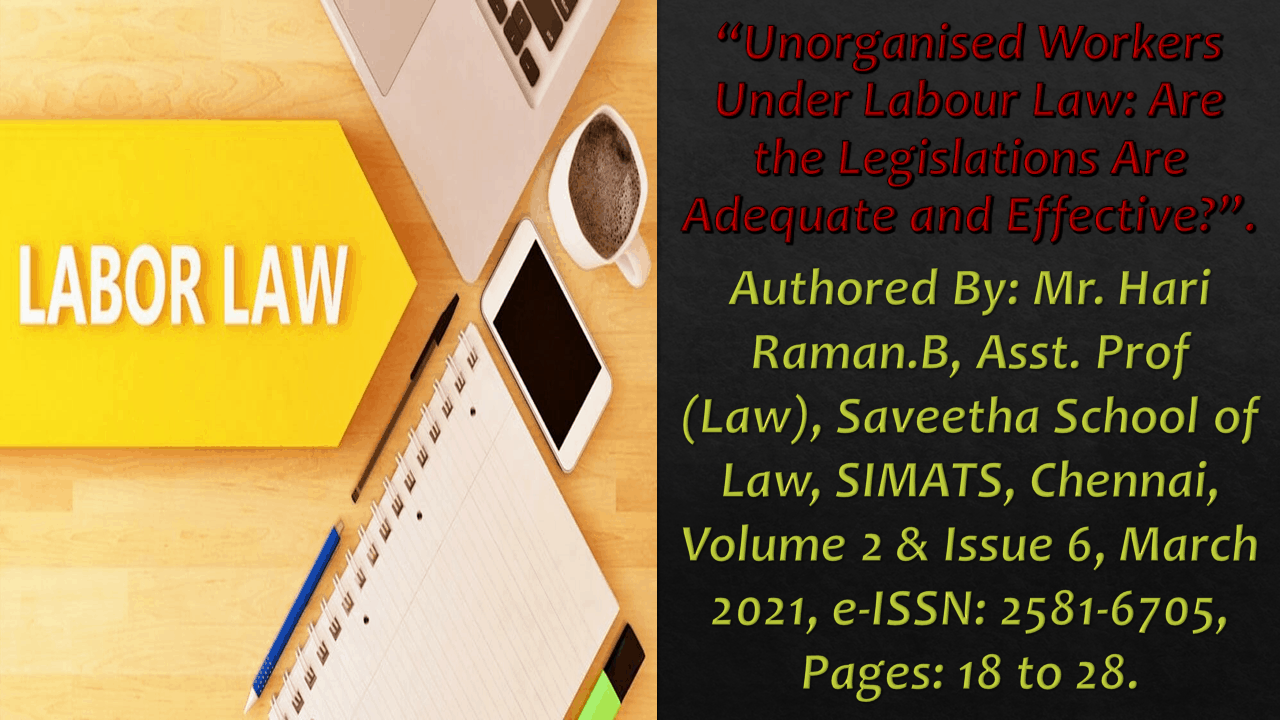Click here to download the full paper (PDF)
Authored By: Mr. Hari Raman.B, Asst. Prof (Law), Saveetha School of Law, SIMATS, Chennai,
Click here for Copyright Policy.
I. INTRODUCTION:
The Indian economy is portrayed by the presence of a larger part of casual or sloppy work business. According to a review did by the National Sample Survey Organization (NSSO) in 2009–10[1], the absolute work in the nation was 46.5 crore including around 2.8 crores in the composed segment and the staying 43.7 crore laborers in the disorderly area.
Out of these laborers in the disorderly segment, there are 24.6 crore laborers utilized in rural part, about 4.4 crores in development work and staying in assembling and administration.
Federal retirement aid is the insurance which society accommodates its individuals against the financial and social misery that in any case would be brought about by significant decrease or stopping of profit coming about because of affliction, maternity, work injury, joblessness, weakness, mature age, and passing; the arrangement of clinical consideration; and the arrangement of appropriations for families and youngsters.
Nonetheless, the federal retirement aid framework won for the chaotic part got run-down and that of the sorted-out division picked up energy.
The Ministry of Labor and Employment so as to guarantee the government assistance of laborers in the chaotic division which, between alia, incorporates weavers, handloom laborers, anglers and fisherwomen, drink tappers, cowhide laborers, ranch workers, beedi laborers, has established the Unorganized Workers’ Social Security Act, 2008.
I.I Objectives:
- To know whether workers of the unorganised sector are protected.
- To know whether labour legislations regarding the protection of unorganised workers are effective.
I.II Review of Literature:
The Indian economy is portrayed by the presence of a larger part of casual or sloppy work business (Bansal and Goel 2018). Social security is basic for the government assistance and gives sureness to the laborers. (India. National Commission for Enterprises in the Unorganised Sector 2008) Social security measures have manifold benefits in advancing the laborers, expanding the creation level of industry and building up the sentiment of guarantee among the laborers (Gupta 2007). It was additionally useful for destroying neediness somewhat. Social security is a central common liberty (Though not one of the Constitutional Fundamental Right). (Rani et al. 2011).
The Planning Commission established a working gathering on Social Security during the cycle of the twelfth Five Year Plan (A. Singh et al. 2014). In India, out of an absolute workforce of 45.9 crores, 94% is in the disorderly sector, and the remaining 6% is in the composed sector. (Saxena 2009) The laborers in the composed sector are secured under social security enactment like workers Provident Funds, Miscellaneous Provisions Act,1952 and Employees State Insurance Act, 1948 (J. Sen and Das 2016). The working gatherings of the Planning Commission comprised subgroups in its first gathering to examine the issues (A. Sen 1988). Taking the advantages of subgroups, the working gatherings have detailed its proposals (Downs et al. 2013). It is trusted that these suggestions would be valuable for the definition of the twelfth five-year plan. (Desai 2020).
At times because of disappointment of appropriate execution of enactments legal executive approach for the assurance of the privileges of disorderly specialists (Sahu 2010). Sloppy laborers to be sure stay outside the domain of social security measures. (M, Sivasubramanian, and I. 2011). Indian Judiciary assumed a crucial part in the advancement of present-day law and made a noteworthy commitment to the assurance of interests of a more fragile segment of society which could be reflected from a few choices. (Lakhani 2004). Legal executives likewise attempted to expand the advantages of work government assistance estimations, for example, the Employees Compensation Act, Payment of Gratuity Act, Employees State Insurance Act, and Employees Provident Fund and so on. (Tom 1989). Legal executives have selective obligation regarding the insurance of enthusiasm of a more vulnerable segment of society (Saikia, n.d.). Through different decisions, the Supreme Court of India accentuated the Right to Livelihood as a characteristic of some portion of Right to Life. (Panda 1999).
I.III Methodology:
The research method followed here is Non-doctrinal research. A total of around 130 responses have been taken from the general public Via Online and Social media. The convenient sampling is used. The sample frame taken by researchers is a public area, college and bus stand. The independent variable taken is Gender and Age. The dependent variable includes ‘‘Protection of Unorganized Sector’’ and ‘Legislations for Unorganized Sector Are Adequate and Effective?’. The statistical tools used for analysis include Graphs.
II. ANALYSIS:
“Table: 1”

Legend: Figure 1 shows the GENDER distribution and opinion on the ‘PROTECTION OF UNORGANIZED SECTOR’.
“Table: 2”

Legend: Figure 2 shows the Age distribution and opinion on the ‘PROTECTION OF UNORGANIZED SECTOR’.
“Table: 3”

Legend: Figure 3 shows the GENDER distribution and opinion on the ‘LEGISLATIONS FOR UNORGANIZED SECTOR ARE ADEQUATE AND EFFECTIVE?’.
“Table: 4”

Legend: Figure 4 shows the Age distribution and opinion on the ‘LEGISLATIONS FOR UNORGANIZED SECTOR ARE ADEQUATE AND EFFECTIVE?’.
II.I RESULTS:
- In figure 1, According to the following question, “Do You think unorganised sectors are protected in India” majority people’s views are considered to be “No” and their least reason are considered to be “Yes”. According to the Gender group – it is found that mostly the female considers answering as ‘No’ and also the minority of Male said ‘No’ BUT majority male said ‘yes’. But however, most of the people in both gender categories consider answering “No” that is “unorganised sectors are not protected in India”.
- In figure 2, According to the following question, “Do You think unorganised sectors are protected in India” majority people’s views are considered to be “No” and their least reason are considered to be “Yes”. According to the Age group – the majority People with age groups of above 40 and 30-40 consider that answers as “No” and the minority of people with age groups of 18-30 and fewer than 18 consider the answers as “Yes”. But however, most of the people in both gender categories consider answering “No” that is “unorganised sectors are not protected in India”.
- In figure 3, According to the following question, “Are the legislation adequate and effective to protect the unorganised sector” majority people’s views are considered to be “No” and their least reason are considered to be “Yes”. According to the Gender group – it is found that mostly the female considers answering as ‘No’ and also the minority of Male said ‘No’ BUT majority male said ‘yes’. But however, most of the people in both gender categories consider answering “No” that is “legislation is not adequate and effective to protect the unorganised sector”.
- In figure 4. According to the following question, “Do You think unorganised sectors are protected in India” majority people’s views are considered to be “No” and their least reason are considered to be “Yes”. According to the Age group – the majority People with age groups of above 40 and 30-40 consider that answers as “No” and the minority of people with age groups of 18-30 and under 18 consider the answers as “Yes”. But however, most of the people in both gender categories consider answering “No” that is “legislation is not adequate and effective to protect the unorganised sector”.
II.II DISCUSSION:
From the survey in figure 1, it is found that the majority of the people stated that “unorganised sectors are not protected in India”. It could be due to the problem in identifying the unorganised sector and overall population in a country. According to the Gender group – it is found that mostly the female considers answering as ‘No’ and also the minority of Male said ‘No’ BUT majority male said ‘yes’. But however, most of the people in both gender categories consider answering “No” that is “unorganised sectors are not protected in India”.
From the survey in figure 2, it is found that the majority of the people stated that “unorganised sectors are not protected in India”. It could be due to the problem in identifying the unorganised sector and overall population in a country. According to the Age group – the majority People with age groups of above 40 and 30-40 consider that answers as “No” and the minority of people with age groups of 18-30 and under 18 consider the answers as “Yes”. But however, most of the people in both gender categories consider answering “No” that is “unorganised sectors are not protected in India”.
From the survey in figure 3, it is found that the majority of the people stated that “legislation is not adequate and effective to protect the unorganised sector”. It could be due to the problem in identifying the unorganised sector and overall population in a country as well as lack of proper legislation and governance regarding labour welfare. According to the Gender group – it is found that mostly the female considers answering as ‘No’ and also the minority of Male said ‘No’ BUT majority male said ‘yes’. But however, most of the people in both gender categories consider answering “No” that is “legislation is not adequate and effective to protect the unorganised sector”.
From the survey in figure 4, it is found that the majority of the people stated that “legislation is not adequate and effective to protect the unorganised sector”. It could be due to the problem in identifying the unorganised sector and overall population in a country as well as lack of proper legislation and governance regarding labour welfare. According to the Age group – the majority People with age groups of above 40 and 30-40 consider that answers as “No” and the minority of people with age groups of 18-30 and under 18 consider the answers as “Yes”. But however, most of the people in both gender categories consider answering “No” that is “legislation is not adequate and effective to protect the unorganised sector”.
III. CONCLUSION:
The same number of issues is looked at by unorganised workers, for example, low wages, misuse of laborers, barbarous states of laborers and so on so the authoritative arrangement of India ensures the privileges of the unorganised specialists with the assistance of different articles secured under the constitution of India. The Government of India made a stride by ordering an enactment “Unorganised Social Security Act, 2008′ for giving basic social security to the disorderly specialists who work in a chaotic sector.
In compatibility of this Act, the Government of India has actualized various plans, for example, Aam Admi Bima Yojana (Life Insurance), mature age benefits plot, Rashtriya Swasthya Bima Yojana (medical coverage) and so forth. From all the analysis part from research, it is found that the majority of the people stated that “unorganised sectors are not protected in India” and “legislation is not adequate and effective to protect the unorganised sector”.
However, it could be due to the problem in identifying the unorganised sector and overall population in a country as well as lack of proper legislation and governance regarding labour welfare.
References:
- Anitha, K., K. Neelamegam, and P. Kanagaraju. 2017. “Confirmatory Analysis on Morale of Women Employees in Unorganised Sector on Work Outcomes.” International Journal of Advanced Scientific Research & Development (IJASRD). https://doi.org/26836/ijasrd/2017/v4/i7/4709.
- Bansal, Ravi Kumar, and Charu Goel. 2018. “Income Pattern and Economic Status of Unorganised Sector Labour in District Meerut.” Journal of Commerce & Trade. https://doi.org/26703/jct.v13i1-13.
- Desai, Kiran. 2020. “Exploitation and Liberation: Case Study of Women Workers in Surat’s Unorganised Sector.” Social Change. https://doi.org/1177/0049085719901051.
- Downs, Shauna M., Anne Marie Thow, Suparna Ghosh-Jerath, Justin McNab, K. Srinath Reddy, and Stephen R. Leeder. 2013. “From Denmark to Delhi: The Multisectoral Challenge of Regulating Trans Fats in India.” Public Health Nutrition 16 (12): 2273–80.
- Gupta, Meenakshi. 2007. Labour Welfare and Social Security in Unorganised Sector. Deep and Deep Publications.
- National Commission for Enterprises in the Unorganised Sector. 2008. Report on Conditions of Work and Promotion of Livelihoods in the Unorganised Sector. Academic Foundation.
- Lakhani, Ram. 2004. “Occupational Health of Women Construction Workers in the Unorganised Sector.” Journal of Health Management. https://doi.org/1177/097206340400600209.
- M, Sivasubramanian, M. Sivasubramanian, and Saifil Ali M. I. 2011. “THE ROLE OF SELF HELP GROUPS (SHGs) IN DEVELOPING WOMEN ENTREPRENEURSHIP IN THE UNORGANISED SECTOR.” International Journal on Information Sciences and Computing. https://doi.org/18000/ijisac.50102.
- Panda, Damodar. 1999. Labour in Unorganised Sector: The Devalued and the Deprived. Manak Publication.
- Raju, Rapaka Satya. 1989. Urban Unorganised Sector in India. Mittal Publications.
- Rani, Jyoti, Research Scholar, Department of Commerce, M. D. University, Rohtak -, Haryana, and India. 2011. “A Study of Educational Interest of Child Labourers Working in Unorganised Auto-Repair Sector in Haryana.” Indian Journal of Applied Research. https://doi.org/15373/2249555x/nov2013/50.
- reddy, G. l. 1992. Education For Unorganised Sector. APH Publishing.
- Sahu, Partha Pratim. 2010. “Subcontracting in India’s Unorganised Manufacturing Sector.” Journal of South Asian Development. https://doi.org/1177/097317411000500103.
- Saikia, Dilip. n.d. “Employment Deceleration in the Unorganised Rural Non-Farm Sector in Assam.” SSRN Electronic Journal. https://doi.org/2139/ssrn.3170665.
- Saxena, K. B. 2009. “The Unorganised Sector Workers’ Social Security Act, 2008: A Commentary.” Social Change. https://doi.org/1177/004908570903900207.
- Sen, Abhijit. 1988. “A Note on Employment and Living Standards in the Unorganised Sector.” Social Scientist. https://doi.org/2307/3517371.
- Sen, Jayanta, and Debarati Das. 2016. “TECHNICAL EFFICIENCY IN INDIA’S UNORGANISED MANUFACTURING SECTOR: A NON-PARAMETRIC ANALYSIS.” International Journal of Business & Management. https://doi.org/20472/bm.2016.4.4.005.
- Singh, Abhinav, Bharathi M. Purohit, Nitin Masih, and Praveen Kumar Kahndelwal. 2014. “Risk Factors for Oral Diseases among Workers with and without Dental Insurance in a National Social Security Scheme in India.” International Dental Journal 64 (2): 89–95.
- Singh, D. P. 2005. Women Workers in Unorganised Sector. Deep and Deep Publications.
- Tom, Irene. 1989. Women in Unorganised Sector: Technology, Work Organisation, and Change in the Silk Industry in South India.
[1] Employment and Unemployment Situation in India 2009-10, available at http://mospi.nic.in/sites/default/files/publication_reports/NSS_Report_No_537.pdf.
Cite this article as:
Mr. Hari Raman.B, Asst. Prof (Law), Saveetha School of Law, SIMATS, Chennai, Unorganised Workers Under Labour Law: Are the Legislations Are Adequate and Effective?, Vol.2, Issue 6, Law Audience Journal, Pages 18 to 28 (2021), available at https://www.lawaudience.com/unorganised-workers-under-labour-law-are-the-legislations-are-adequate-and-effective/.




